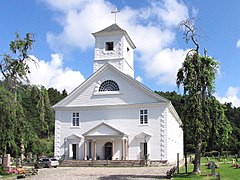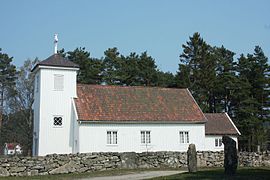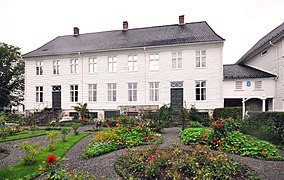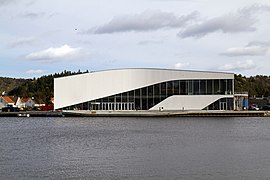Mandal
Mandal is a town and former municipality in the province ( Fylke ) Agder in Norway .
geography
Mandal is the southernmost city in Norway. It is located 45 km west of Kristiansand at the mouth of the Mandalselva River in the North Sea .
The shore at Mandal consists essentially of sand, so that around 1900 measures had to be taken against erosion. In a major action, pines from Scotland (Giuthas Albannach / Scottish Föhren) were planted on the sand dunes. Between 1905 and 1935 that was 100,000 seedlings. In 1969 part of the old forest on an area of 2000 m³ was lost due to a huge storm.
The European route 39 runs in the north of Mandal.
Former municipality
Mandal was an independent municipality until January 1, 2020 . 15,659 inhabitants lived in an area of 222 km² (as of January 1, 2019). Their municipality number was 1002, their postcode 4517. The last mayor was Alf Erik Andersen ( FrP ). In the course of local government reform in Norway , Marnal and Marnardal were merged with Lindesnes .
history
Mandal was mentioned at the end of the 14th century under the name "Vester-Risør", when King Eric of Pomerania gave the place the right to trade in the later famous Mandal salmon. At that time, the citizens of Landskrona in what was once the Danish town of Skåne had exclusive trading rights in Vester-Risør.
The place had urban settlements west of Sjøsanden (today's Mandal beach), at the entrance to the Skogsfjord, a small trading post called Spidsbo. Another place with early settlement was on the banks of the Mandalselva River , once called Marndal or Mandal. The settlement had, among other things, a separate church from the 15th century. Mandal is thus one of the southernmost oldest cities in Norway. In addition, there was another settlement in nearby Kleven, where the natural harbor was crucial. In historical times, Kleven was a very important port along the entire coast of Agder, because there was a loading and unloading station here. It can be assumed that around 1500 wood was loaded here, which mainly went to the Netherlands . The trading post Vester-Risør was first mentioned in 1632 with fee-based location privileges. It took place in 1662 with newer trading privileges the renaming of Vester-Risør in Mandal.
From 1809 to 1815, salt was produced in a salt works in Mandal. In 1862 a paraffin factory was built using a manufacturing method developed in Scotland . In 1872 the factory had to give way to foreign competition and close. But the good relationships, which were based on the fact that leading families had emigrated to Scotland and there finally, in the person of Lord Edward Salvesen, occupied one of the 13 seats in the High Court of Justice from 1905 to 1922, have been preserved until very recently.
The old stone church from the 16th century was destroyed in the town fire of 1810. Today's Mandal Church was built in the Empire style after the fire of 1810 and was completed in 1821. It is considered the largest wooden church in Norway and has 1,800 seats.
Mandal received city rights in 1837 (a modification is said to have been made in 1921). The trade in fish and in particular in salmon was greatly expanded abroad. The 19th and 20th centuries brought Mandal great growth and a large number of new businesses, as well as a strong relationship with art. Salmon fishing and trading made Mandal a rich trading town.
During the Second World War , up to 2000 soldiers were stationed in the area , some of whose bunkers and trenches can still be seen.
Since the time after 1945, Mandal has also experienced a notable influx of tourists. Growing prosperity and a lively interest in art are reflected in public life, for example on the sculpture bank of the Mandalselva river with the statue “Mandalitten” donated by a savings bank, which symbolizes: “Salmon in your pockets, eggs in your shoes and fine bread in the hat ”.
Attractions
- The cityscape with the white houses
- The church in Mandal is one of the largest in Norway with 1,800 seats. The church was built in Empire style in 1821 and is protected as a cultural monument.
- The church of Harkmark dates from 1613 and is a listed building.
- Andorsengården City Museum , built 1801–1805, contains a collection of paintings, including a. with paintings by Gustav Vigeland . The manor is a listed building.
- The Buen-Kulturhaus, completed in 2012, combines a library, a cinema as well as a theater and concert hall under one roof.
- The lookout point “Uranienborg” with its pavilion and the view over the city
- The Mandal runestone was discovered in a garden in the village in 2012. It is the first runestone found in Norway since 1947.
- The Harkmark Stone Circle is the southernmost megalithic monument in Norway.
economy
The Umoe Mandal shipyards are located in Mandal . The local newspaper for the surrounding communities Lindesnes is published here.
Personalities
- Kjell Askildsen (* 1929), writer
- Ole-Johan Dahl (1931–2002), Norway's first computer science professor
- Edvard Christian Danielsen (1888–1964), Vice Admiral and from 1949 to 1951 Commander in Chief of the Norwegian Navy
- Ansgar Gabrielsen (* 1955), conservative politician
- Ellen Gleditsch (1879–1968), chemist
- Olaf Isaachsen (1835–1893), painter of the Düsseldorf School
- Einar Iversen (1930–2019), jazz pianist
- Søren Jaabæk (1814–1894), Norwegian farmer and politician
- Janne Haaland Matlary (* 1957), political scientist, Catholic church activist and conservative politician
- Åse Michaelsen (* 1960), politician
- Amaldus Nielsen (1838–1932), painter
- Hans Matthias Elisæus Ross (1833–1914), theologian, linguist and champion for the Norwegian Nynorsk
- Helge Sivertsen (1913–1986), discus thrower and politician of the labor party
- Michael Grundt Spang (1931–2003), author and journalist
- Adolph Tidemand (1814–1876), painter
- Emanuel Vigeland (1875–1948), painter
- Gustav Vigeland (1869–1943), sculptor
- Kari Vinje (* 1931), children's book author
Web links
Coordinates: 58 ° 2 ′ N , 7 ° 27 ′ E









